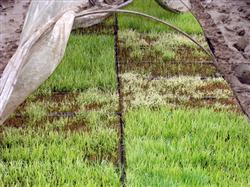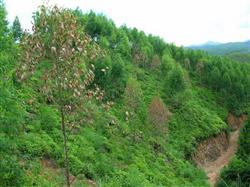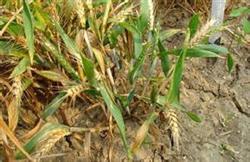susceptible Learn more about susceptible
-
Xu Mai 30

Long awn, white shell, white grain, spindle spike, semi-hard grain, semi-creeping seedlings, dark green leaves, wide leaves and good cold resistance. The tillering ability is stronger and the number of panicles is more. The plant type is loose, the appearance is elegant, the plant height is about 85 cm, the stem elasticity is good. The whole growth period is about 239 days, which is 3-4 days longer than the control. The effective panicle is about 390000 per mu, about 31 grains per panicle, and the 1000-grain weight is about 45 grams. The results of inoculation identification: susceptible to scab, moderately susceptible to sheath blight, highly susceptible to spindle stripe mosaic virus, susceptible to panicle sprouting.
2019-01-15 -
A New late Indica Hybrid Rice combination

Teyou 37 is a new hybrid late indica rice combination selected by Nuclear Farmers Institute of Zhejiang University, with an average yield of 448 per mu in 2000. 8 kg, an increase of 1% over Shanyou 10. 91%. The results of the two-year zone test showed that the average whole growth period was 129. In 8 days, the average effective panicle per mu was 17. 50,000, with a seed setting rate of 83. 7%, 1000-grain weight 26. Nine grams. The results of resistance identification were as follows: moderately resistant to rice blast, susceptible to bacterial blight, susceptible to white-backed planthopper, susceptible to brown planthopper, rice quality test results: milled rice rate, whole seed
2019-01-16 -
Some medical histories may indicate that children are susceptible to asthma

Asthma in children accounts for a high proportion of asthma, and many bronchial asthma occurs in children, even in early childhood. In other words, many children have had childhood asthma and were cured in time. Infants and children are resistant.
2018-05-13 -
Common knowledge of Rice Black-streaked Dwarf Disease in South China

Rotten rice seedlings are the general name of rotten seeds, rotten buds and dead seedlings that occur in the seedling stage. Rotten rice seedlings can be divided into two types: physiology and infectivity. Physiological rotten seedlings are mainly caused by low temperature and poor management measures, infectious rotten seedlings are caused by pathogen infection, and the main diseases are rice cotton rot, rice rot and rice.
2018-09-13 -
Nanjing 41 (rice)

Nanjing 41 is a late-maturing medium japonica rice variety, which was bred by Grain cultivation Institute of Jiangsu Academy of Agricultural Sciences. In the production experiment in 2002, the average yield per unit area was 610.05 kg / mu, which was 3.44% higher than that of Wuyujing 3. The characteristic plant height is 94 cm, the whole growth period is 148 days, moderately susceptible to leaf blast, susceptible to ear blast, moderately resistant to bacterial blight, susceptible to sheath blight, and excellent rice quality. Suitable for planting under the condition of middle and high fertility in the middle part of Jiangsu Province.
2019-01-16 -
Huamai 2

Long awn, white hull, red grain, spindle panicle, semi-hard-soft grain. Seedling erect, leaves broad and long, pale green leaves. Tillering ability is stronger, panicle and grain number per panicle are more, 1000-grain weight is slightly lower. The plant type is loose, the plant height is about 84 cm, and the fertilizer resistance is strong. The growth period is about 211 days, one day longer than the control. The effective panicle per mu is about 320,000, with about 38 grains per panicle and about 39 grams of 1000-grain weight. Inoculation identification results: moderate resistance to scab, susceptible to sheath blight, highly susceptible to shuttle stripe mosaic disease, highly resistant to preharvest germination. The field performance is medium susceptible to sheath blight and powdery mildew. Quality analysis of two
2019-01-15 -
How rabbits are susceptible to coccidiosis without sweat glands how to help rabbits spend the summer safely

How rabbits are susceptible to coccidiosis without sweat glands how to help rabbits spend the summer safely
2018-07-14 -
How does eucalyptus control bacterial wilt?

How does eucalyptus control bacterial wilt? Bacterial wilt of eucalyptus is a bacterial wilt disease. In recent years, with the continuous increase of eucalyptus varieties (lines) and the rapid increase of plantation area in South China, the occurrence of eucalyptus bacterial wilt is becoming more and more serious and has become an important obstacle to eucalyptus production. In the eucalyptus wilt disease.
2018-07-18 -
Control techniques of duck plague

Control techniques of duck plague
2018-07-04 -
Prevention and treatment of susceptible diseases of goats in winter

1. Rapid epidemic of sheep: the disease occurs suddenly, and there is almost no time for treatment, giving priority to immune prevention. the commonly used vaccine is the triple vaccine of enterotoxemia in sheep or the five vaccine of enterotoxemia in lambs with dysentery in lambs. Subcutaneous injection of 5ml, note
2020-11-08 Winter goats susceptible disease prevention and control methods one sheep fast -
Occurrence and Control Countermeasures of Wheat Yellow Dwarf Disease

Wheat yellow dwarf disease is a viral disease mainly transmitted by aphids, and its damage is quite serious in some years. When the symptom is susceptible to disease at the seedling stage, the leaves lose green and turn yellow, and the plants are seriously dwarfed, and the leaves of seriously diseased plants often cannot survive the winter, or cannot jointing and heading after overwintering. The dwarfing of the late susceptible plants was not obvious, and the upper part.
2018-09-13 -
Huamai 3

Long awn, white shell, white grain, spindle spike, grain semi-hard. The seedlings are semi-erect, the leaves are dark green, the cold resistance and spring cold resistance are general, and the tillering ability is general. The plant type is compact, the ear layer is neat, and the mature phase is better. The plant height is about 82 cm and the lodging resistance is good. The whole growth period is about 223 days, which is equal to that of the control. The effective panicle is about 360000 per mu, about 30 grains per panicle, and the 1000-grain weight is about 46 grams. Inoculation identification results: susceptible to scab, sheath blight, highly susceptible to spindle stripe mosaic, moderately resistant to panicle sprouting. Susceptible to powdery mildew, sheath blight and scab in the field
2019-01-16 -
Cultivation methods of colorful calla lilies

Cultivation methods of colorful calla lilies
2019-03-07 -
Classification of susceptibility to disease in dogs

In fact, dogs can be divided into several categories: malignant infectious diseases, non-malignant diseases, functional diseases and nutritional diseases. 1. Malignant infectious diseases: mainly dog distemper, canine parvovirus, infectious hepatitis, rabies and other highly contagious and fatal diseases. Rabies is a zoonotic disease. there are many ways of transmission of these diseases and the cure rate is relatively low. although there is now a corresponding vaccine, puppies and dogs whose resistance to epidemic prevention has declined sharply due to some reasons (cured at the beginning of a serious illness and giving birth to puppies.
2019-01-16 -
Relationship between bronchial Asthma and Heredity

One of the causes of bronchial asthma is heredity. In fact, it should be said that it will inherit susceptible constitution, that is, allergic constitution. And this allergic constitution is not necessarily bronchial asthma, but easy to get allergic diseases.
2018-05-12 -
Control methods of branch blight of asparagus

[symptoms] first occurred on the weakening branchlets, the disease spot was filamentous or spindle-shaped at first, and gradually extended to the upper branches, resulting in leaf shedding. The susceptible branches gradually become light brown, and finally become light yellow. When the environment is wet, there are dense black dots on the susceptible branches. [pathogen and pathogenesis] fungal diseases
2019-03-04 -
Introduction of Wheat Variety Gaomai 6

The whole growth period of semi-winter wheat variety Gaomai 6 was 228 days, which was one day earlier than that of the control variety Zhoumai 18. The plant height is 77.1 cm, the plant type is compact, the stem is elastic and the lodging resistance is strong. The flag leaf is short and wide, upthrust, the spike layer is neat, and the ripe phase is good. Identification of disease resistance and high susceptibility to sheath blight
2020-11-08 Gaomai 6 Wheat Variety introduction Bandong Sex -
Fine feeding of Sheep with Poor Feed and susceptible to Disease in Winter

Fine feeding of Sheep with Poor Feed and susceptible to Disease in Winter
2018-07-11 -
How to diagnose vesicular disease in pigs

Common vesicular diseases of pigs include foot-and-mouth disease, vesicular disease, vesicular rash and vesicular stomatitis, etc., all of which are characterized by blisters on the mouth and feet. 1. Foot and mouth disease. It infects a variety of animals, mainly cloven hoofed animals, and humans can also be infected. Cattle are susceptible, followed by pigs, sheep, goats and camels, and young animals are susceptible. Infectious sources are sick animals and infected animals, and transmission vectors are respiratory tract, digestive tract and wound. There is no seasonal epidemic, but it occurs more in winter and spring.
2019-01-15 -
Leaf rust of spruce

Spruce leaf rust is distributed in Sichuan, Yunnan, Gansu, Qinghai, Taiwan and other places. The disease harms Lijiang spruce, scaly spruce, coarse spruce, oil wheat spruce, Linzhi spruce, snow spruce and Siberian spruce. Symptoms: the young buds are susceptible, the needles on the newly growing shoots turn yellow or orange, short and thick, and the diseased leaves produce orange cushion-like winter spores or blister-like spores, the diseased buds look like a yellow flower, and soon the diseased leaves turn black and die. The susceptible 2-year-old leaves turn yellow locally, producing blister-shaped spores, or orange-yellow cushions.
2019-01-16
